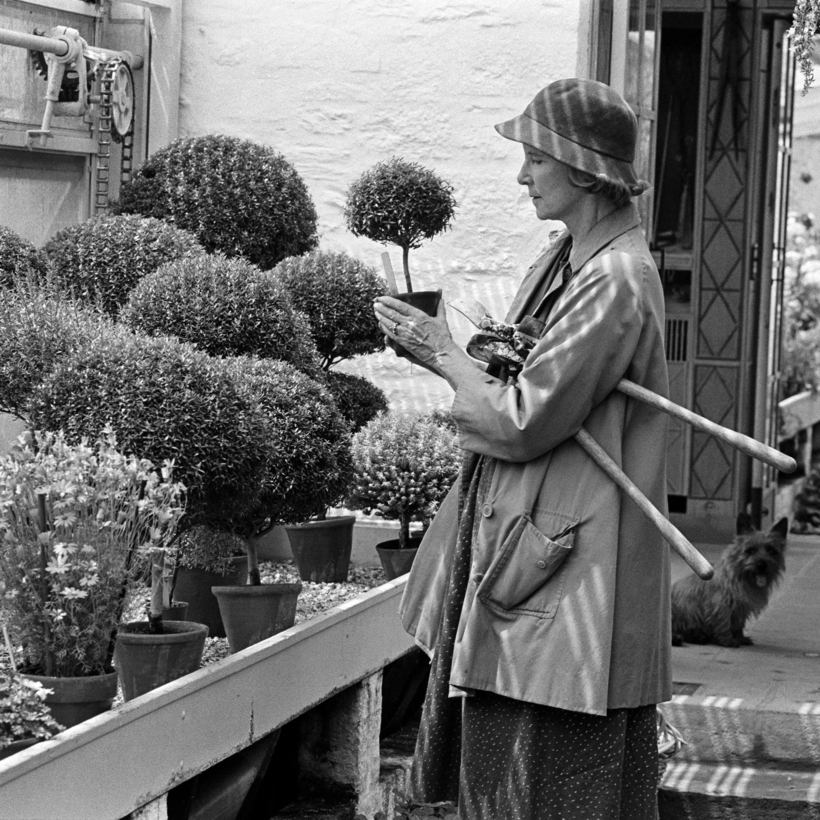“Nothing should be noticed,” Bunny Mellon famously decreed. Indeed, she was the master of understated refinement, fetishistic in her fervor to pare away anything extraneous, inside and out. In her gardens she had an extreme need to prune and pleach.
At Oak Spring Farm, the 4,000-acre estate in Upperville, Virginia, where she created an American Arcadia, every detail was painstakingly wrought, particularly in her crowning achievement, the Garden Library, a modernist shard of whitewashed stone set in a rolling field overlooking the Blue Ridge Mountains.
After one gentleman paid a visit to the library, he wrote to Mellon, telling her that the experience had been “a life-changing event.” According to Mac Griswold’s I’ll Build a Stairway to Paradise: A Life of Bunny Mellon, she promptly phoned to thank him. “Nobody really notices what I do,” Mellon told him, in tears.

Producing perfection can be a lonely business, as Griswold underscores throughout this exhaustively researched and elegantly written biography. In addition to her expertise in horticulture, Griswold drew on her personal familiarity with the Mellon family, which began in 1956, when she and Mellon’s daughter Eliza enrolled at Foxcroft. In the 1990s, Mellon asked Griswold to help her write her memoirs. They had informal meetings and conversations before Mellon abandoned the project. After Mellon’s death, in 2014, at 103, Griswold embarked on this volume.
A granddaughter of the inventor of Listerine, Rachel Lambert (nicknamed “Bunny” by her nurse) was brought up at impressive estates in New Jersey and Virginia. But like most women of her time and class, her options were limited. With her sensitivity to her environments, she recognized architecture and garden design as her best means of personal expression. She saw beauty “as a practical, working construct, a vehicle to another world,” as Griswold writes.
At 22, Mellon married Stacy Barcroft Lloyd Jr., the affable son of a Philadelphia banker. Living in Virginia horse country, they socialized with Mary and Paul Mellon, who had inherited a fortune—reportedly the world’s largest—from his father, Andrew, the financier and industrialist. In 1948, two years after Mary’s death, from asthma, Bunny startled Stacy when she asked for a divorce. “But, Bunny, don’t you love me?” he asked. “I do love you, Stacy, but I want to be Mrs. Paul Mellon,” she responded.

Within a few years, Paul and Bunny’s marriage went cold. But they came to an understanding. She found him a girlfriend, who remained his mistress until his death, in 1999, at 91. She had passionate friendships with a series of handsome, creative men, all gay, beginning with Cristóbal Balenciaga and Hubert de Givenchy. (In their Paris ateliers, each couturier maintained a separate workroom, staffed by a dedicated team of seamstresses, to produce Bunny’s extensive wardrobe.)
Sexless though it remained, Mr. and Mrs. Mellon’s life together was unmatched in its scale and splendor. With his unlimited funds, she created sublimely beautiful homes—filled with treasure after treasure—in New York, Paris, Antigua, Nantucket, Cape Cod, and Washington, in addition to Virginia.
It was a private universe in which seemingly anything was possible. According to Griswold, Mellon wanted “to alter mundane reality.” With a 350-person staff, she could pretty much do it. (At Oak Spring, 15 people were employed in the tree department alone; there were carpentry, sheet-metal, and fire departments, too.)
In recounting Mellon’s 103 years, Griswold doesn’t always proceed chronologically; there are several thematic sections, notably “Bunny and the Kennedys.”

Their intimate relationship began in 1958, when a mutual friend brought Jackie to tea at Oak Spring. “I love your house, but I don’t love mine,” said a wide-eyed Jackie, then the wife of the junior senator from Massachusetts. Nineteen years older, Bunny became a maternal figure, a mentor, and a benefactor.
Bunny and Jackie were cut from the same cloth: “The two shared a childlike imagination and enthusiasm,” Griswold writes, as well as “a profound belief in the absolute ability of style to carry real meaning…. Beneath their perfect society manners and oddly similar whispering voices ran an electric current of power. They could move, manipulate, and cut—with finality.”

With the book’s breaks in chronology, characters sometimes ricochet through it. After a brief mention of Eliza’s lavish 1968 wedding, for instance—for which Mellon drafted seven-year-old John Kennedy Jr. to serve as page boy, dressing him in British court–style silk knee breeches—Eliza appears next 80 pages later, in 1995, in a reference to her “long romantic liaison with Doris Sanders” (a woman 19 years her senior, who had previously been the partner of the writer Patricia Highsmith). Oh.
Though she was an amateur, everything Bunny Mellon created was on a professional level, particularly the gardens she designed in France for Givenchy and at the White House for the Kennedys (Mellon’s famed Rose Garden). “She’s the greatest landscape gardener and architect in this country,” said the architect I. M. Pei.
Notwithstanding her extreme discretion, Griswold sees Mellon ultimately as an impresario and a showman who theatrically created one spectacular work of fantasy after another. She sure had quite a run.

James Reginato, a writer at large for Vanity Fair, is the author of Growing Up Getty: The Story of America’s Most Unconventional Dynasty

